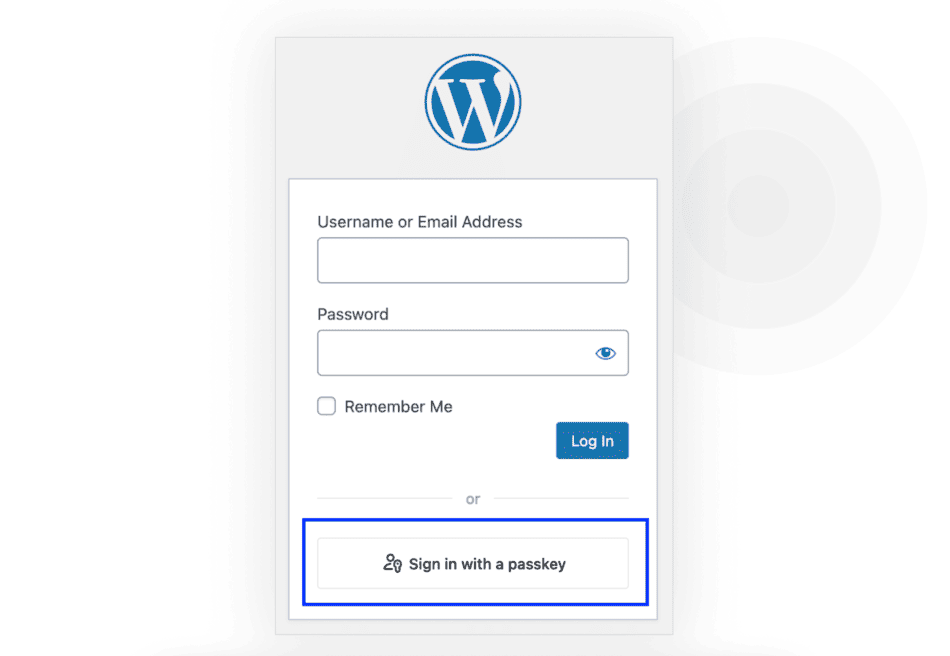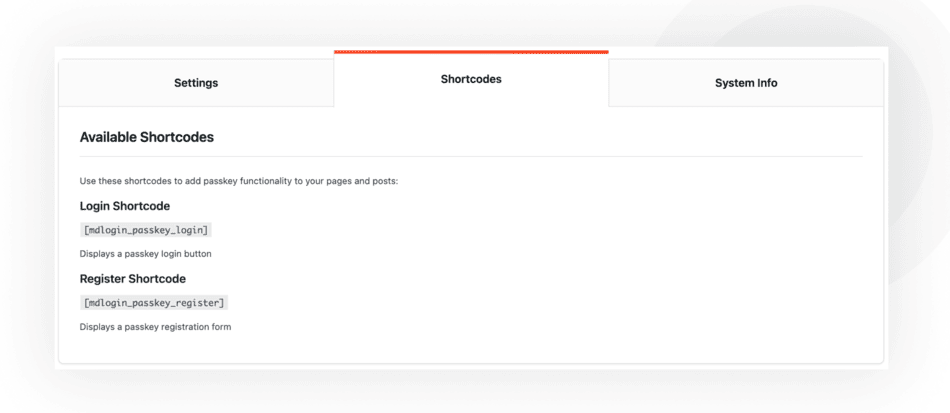Table of Contents
Key Takeaways
- Strengthen WordPress login security by implementing a passwordless login in WordPress with a Multidots Passkey Login plugin.
- Replace traditional passwords with FIDO2/WebAuthn passkeys for instant biometric or device-based authentication.
- Configure and manage everything easily — no code needed, just toggle settings and use shortcodes.
- Works perfectly for membership sites and agencies that want a secure, one-tap login experience.
If you still rely on usernames and passwords for WordPress, you increase risks for your site and users. Weak passwords, forgotten passwords, and phishing are common problems. The better way is passwordless login on WordPress sites that can be used today.
In this guide, you will learn how to add passwordless authentication in WordPress with the Multidots Passkey Login plugin. We explain what passwordless means, how passkeys work, how to set it up step by step, and where it shines in real sites.
Why Passwordless Login Is the Future of WordPress
Every WordPress admin knows the pain of password resets, forgotten credentials, and user lockouts.
Traditional login systems are slow, frustrating, and risky — hackers exploit weak or reused passwords every day.
That’s why more websites are switching to passwordless authentication in WordPress using passkeys. It’s faster, more secure, and feels like logging in with a phone’s Face ID — no password required.
In this article, we’ll show you how to add passwordless login to WordPress sites can use today with the Multidots Passkey Login plugin — powered by modern FIDO2/WebAuthn technology.
What is Passwordless Login in WordPress?
Normally, WordPress requires a username and a password to block unauthorized access.
But this method has two major flaws: users forget passwords, and attackers steal them.
A passwordless authentication WordPress setup solves both problems.
It lets users verify their identity through a secure device instead of typing a password.
With the Multidots Passkey Login plugin, users can log in using:
- Face ID or Touch ID on Apple devices
- Windows Hello on PCs
- A security key or device PIN
No more remembering passwords. No more reset emails. Just instant, secure access.
Why Choose Passwordless Authentication?
1. Stronger Security
The WordPress passkey login plugin eliminates password-related issues. Instead, it uses public-key cryptography (FIDO2/WebAuthn). Even if hackers breach your site, they can’t use what they find — no stored credentials exist.
2. Better User Experience
Users log in with a single tap or fingerprint. It’s frictionless and mobile-friendly — exactly what users expect these days.
3. Lower Support Costs
You’ll see fewer password-reset tickets and fewer “locked-out” users — saving time and support effort.
4. Future-Proof Technology
Passkeys are now supported by Apple, Google, and Microsoft, meaning your site aligns with global security standards from day one.
Password-based vs Passwordless: A Quick Comparison
| Aspect | Password-based | Passwordless (Passkeys) |
| Credential stored on the server | Yes (hashed password) | No (only public key stored) |
| Vulnerability to phishing/reuse | High | Very low |
| User friction | High (remember/forgot/reset) | Very low (one tap) |
| Multi‐factor built in? | Depends | Yes (device + biometric/PIN) |
| Cost of resets/support | High | Lower |
Switching to passwordless means removing the weakest link (the human-remembered password) and streamlining access.

Overview of Passkeys (FIDO2 / WebAuthn)
What are Passkeys?
Passkeys are modern credentials based on FIDO2 and WebAuthn. They let users log in without passwords. The key lives on the device or syncs through a trusted platform. The user confirms with a biometric or a local PIN. This is the core of a FIDO2 WebAuthn WordPress plugin.
How Passkeys Work
- Registration. The device creates a private and public key. Your WordPress site stores the public key. The private key never leaves the device.
- Login. The site sends a one-time challenge. The device signs it after biometric or PIN approval. Your site verifies the signature with the public key.
- Result. Strong, phishing-resistant login with built-in multi-factor.
Security Advantages and Compatibility
- Phishing resistance. There is no password to steal or reuse.
- Strong authentication. Biometric or device PIN adds local proof.
- Broad support. Major browsers support passkeys. Chrome, Safari, and Edge work on iOS, Android, macOS, and Windows.
- Future proof. Passkeys are backed by platform vendors and the FIDO Alliance.
What Is Multidots Passkey Login Plugin?

The Multidots Passkey Login plugin brings enterprise-grade passwordless authentication to WordPress. It uses FIDO2 and WebAuthn to verify users securely via their devices.
Once installed, users can register a passkey, authenticate using their fingerprint, Face ID, or PIN — and access their account instantly.
It integrates seamlessly with the native WordPress login screen and supports both desktop and mobile browsers.
Key Features
- Passwordless login with Face ID, Touch ID, Windows Hello, device PIN, or hardware keys
- Works with existing users — no re-registration needed
- Admin options: enable/disable passkeys, limit passkeys per user, session timeout
- HTTPS enforcement for secure operation
- Shortcodes:
- [mdlogin_passkey_login] — adds a login button
- [mdlogin_passkey_register] — lets users register passkeys
- [mdlogin_passkey_login] — adds a login button
- Cross-browser support — Chrome, Safari, Edge, Firefox
- Platform compatibility: iOS, Android, macOS, Windows
How to Set Up Passwordless Login in WordPress
Follow these simple steps to add passwordless login WordPress functionality to your site using Multidots Passkey Login.
Step 1: Install and Activate the Plugin
Go to your WordPress Dashboard → Plugins → Add New,
search for “Multidots Passkey Login”, and click Install → Activate.
Once activated, the plugin adds a “Sign in with a passkey” button to your default WordPress login screen. Users can still log in with their password, but now they’ll see a new option: Sign in with a passkey.

Step 2: Enable Passkey Login
After activation, go to Dashboard → Passkey → Settings in your WordPress admin panel.
Here you’ll find the main configuration page with all the plugin’s options.
General Settings:
- Enable Passkey — Turns on passwordless login.
- Require HTTPS — Ensures passkeys only work over a secure connection.
- Session Timeout — Set how long users remain logged in (default: 300 seconds).
- Max Credentials per User — Limit how many devices can register a passkey.
Click Save Changes after configuring.

Step 3: Add Passkey Buttons Using Shortcodes
You can display the passkey login and registration buttons anywhere on your site using two simple shortcodes:
- Login Shortcode: [mdlogin_passkey_login]
Displays a “Sign in with a passkey” button. - Register Shortcode: [mdlogin_passkey_register]
Displays a passkey registration form.
You can embed these shortcodes in:
- A login page or pop-up
- Member dashboard
This gives you full control over where users can register or use passkeys.

Step 4: Manage Passkeys
Admin can manage their registered passkeys right from their WordPress admin dashboard.
Admins can also see:
- Username and email
- Passkey status (Active/Inactive)
- Credential ID linked to each passkey
This makes it easy to monitor usage, revoke access, or reset credentials when needed.

Comparison: Multidots vs Other Passwordless / Passkey Plugins
Before choosing a passwordless login WordPress solution, it’s important to understand how the Multidots Passkey Login plugin compares with other popular options. Each plugin takes a slightly different approach — from true FIDO2 WebAuthn WordPress plugins that use passkeys to simpler magic-link methods.
If you’d like to explore a complete list with detailed pros and cons, we’ve created a helpful roundup here:
👉 Best Passwordless Login WordPress Plugin – Top Picks Compared.
That article breaks down multiple plugins, their key features, and compatibility, so you can decide which one fits your needs best.
Here’s a quick comparison snapshot below:
| Plugin | Authentication Method | Ideal For | Key Differences |
| Multidots Passkey Login | Passkeys (FIDO2/WebAuthn) – biometrics, device PIN, security key | Sites needing enterprise-grade passwordless login | Built by WordPress VIP Gold agency, shortcodes, admin controls, and comprehensive security updates. |
| WP‑WebAuthn | Passkeys (WebAuthn) | Developers/power-users needing advanced WebAuthn integrations | More technical, supports usernameless login, fewer non-technical admin UX features. |
| Secure Passkeys | Passkeys (WebAuthn) | e-commerce/membership sites | Focused on integration with WooCommerce/membership plugins. |
| Magic Login | Magic Link (email-based passwordless) | Simple blogs or community sites | Simpler to implement but less secure than true passkeys (email link still vulnerable to email compromise). |
Real-World Use Cases and Tips
Where Passwordless Helps Most
- Membership sites. Fewer resets and stronger trust.
- Agencies and enterprise teams. Editors and admins log in often. Passkeys save time.
- Any biometric login WordPress site. Face ID or Touch ID makes daily access simple.
Implementation Tips and Limitations
- Enforce HTTPS before launch.
- Keep a fallback path while users adopt passkeys.
- Educate users. Biometric data stays on the device. The site stores only a public key.
- Test across browsers and platforms.
- Plan recovery. If a device is lost, allow new passkey registration after identity checks.
Summary & Final Thoughts
Switching from traditional password logins to a modern, passkey-enabled system is no longer a fringe idea — it’s becoming a best practice. With the Multidots Passkey Login plugin, WordPress site owners can implement enterprise-grade passwordless login (biometric/passkey) quickly, with minimal fuss and maximum security benefit.
If you’re running a site where login friction matters or where credential security is a concern, implementing this plugin is a smart move. Pair it with HTTPS, user education, and monitoring, and you’ll not only improve security — you’ll improve the login experience for everyone.
Install the plugin today, register one test passkey yourself, and see how smooth login becomes. Then promote the change to your users. Your “forgot password” queue will thank you.
Say goodbye to passwords — make WordPress login faster, safer, and simpler.
Frequently Asked Questions About Passwordless Login in WordPress
1. Is passwordless login really more secure than using passwords?
Yes. Passwordless login is far more secure because it removes the biggest risk — passwords themselves.
The Multidots Passkey Login plugin uses FIDO2/WebAuthn, which relies on device-based private keys. These keys never leave the user’s device and cannot be phished, guessed, or reused. Even if someone gets access to your server, they still can’t log in without the user’s physical device.
2. Do passkeys work on all browsers and devices?
Yes. Modern browsers and platforms now support passkeys, including:
- Chrome, Safari, Firefox, Edge
- iOS and Android
- macOS and Windows
- Devices with Face ID, Touch ID, Windows Hello, or USB security keys
This makes passwordless authentication in WordPress setups seamless on both mobile and desktop.
3. Do I need HTTPS to use passkeys?
Yes. Passkeys require HTTPS because WebAuthn communicates sensitive authentication data. The plugin includes a “Require HTTPS” setting to ensure security. If your site isn’t using SSL yet, install an SSL certificate before enabling passkeys.
4. Do biometrics get stored on my WordPress site?
No — never.
Biometric data like Face ID or fingerprints stay on the user’s device only. Your WordPress site stores only a public key, which cannot reveal anything about the user’s biometric identity.
5. Is the Multidots Passkey Login plugin free?
Yes, the plugin is fully free and available on WordPress.org. There are no premium upgrades needed to use passkeys, shortcodes, or admin features.



